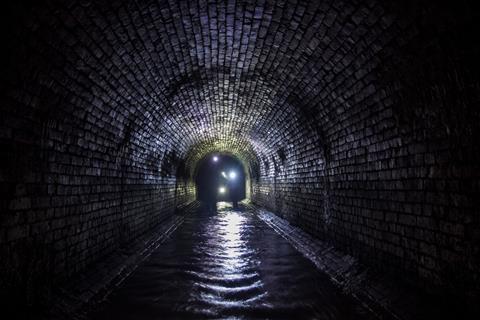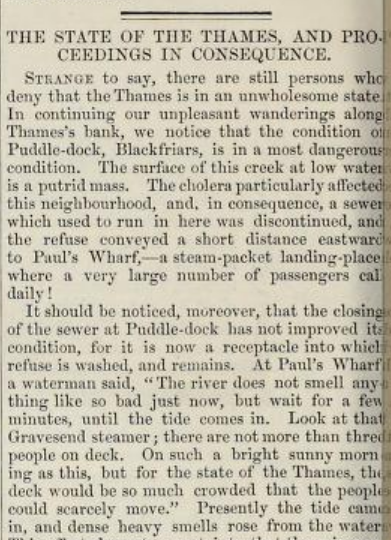London’s sewer network collapses, creating a public health emergency as a cholera epidemic sweeps the capital. The Builder reports from the scene

In the summer of 1858, London was plunged into crisis when its antiquated sewer system collapsed under the pressure of the city’s booming population. One tributary of the Thames had become a “putrid mass”, The Builder reported, while any sewage which did make it out to sea was quickly swept back by the incoming tide. Cholera, the water-borne disease which plagued the capital at this time, tore through the city’s poor and wealthy districts alike, killing thousands who depended on the polluted river for drinking water.

The public health emergency was quickly dubbed the “Great Stink” by the nation’s newspapers, which called on the government and its infrastructure improvement body, the Metropolitan Board of Works (MBW), to urgently find a solution. The news story below paints the scene of that summer and lists some of the more hair brained proposals for cleaning up the mess.
Eventually it was the MBW’s chief engineer Joseph Bazalgette’s plan to hugely expand the capital’s sewer network which won the backing of ministers. One of the most ambitious infrastructure schemes of the 19th century, it resulted in the construction of the Victoria, Albert and Chelsea embankments and more than 130km of underground sewer tunnels. Bazalgette was knighted for his efforts. The historian John Doxat said that he “probably did more good, and saved more lives, than any single Victorian official”.
News item in The Builder, 10 July 1858
THE STATE OF THE THAMES, AND PROCEEDINGS IN CONSEQUENCE.
Strange to say, there are still persons who deny that the Thames is in an unwholesome state. In continuing our unpleasant wanderings along Thames’s bank, we notice that the condition of Puddle-dock, Blackfriars, is in a most dangerous condition. The surface of this creek at low water is a putrid mass. The cholera particularly affected this neighbourhood, and, in consequence, a sewer which used to run in here was discontinued, and the refuse conveyed a short distance eastward to Paul’s Wharf, a steam-packet landing-place where a very large number of passengers call daily!
It should be noticed, moreover, that the closing of the sewer at Puddle-dock has not improved its condition, for it is now a receptacle into which refuse is washed, and remains. At Paul’s Wharf a waterman said, “The river does not smell anything like so bad just now, but wait for a few minutes, until the tide comes in. Look at that Gravesend steamer; there are not more than three people on deck. On such a bright sunny morning as this, but for the state of the Thames, the deck would be so much crowded that the people could scarcely move.” Presently the tide came in, and dense heavy smells rose from the water. This effect shows to a certainty that the poisonous matters passed into the river are returned with each tide, instead of being carried away to sea.

At Paul’s Wharf the pier is distant from the shore 175 feet, and the surface exposed on the south side, at low water, is rather more than this so that in the case of embankment about 350 feet at least must be taken from the river.
At some of the inlets, for instance that at Queen hithe, a sort of bar is formed of gravel, or some such matter, which increases in size, and shuts in at low water a considerable quantity of mud mixed with other refuse.
At low water, at this point, it should be remarked that, although such a large surface of shore is exposed, the smell was nothing to be compared with that which arose from the water, when the tide came in, and this seemed to increase as the steam vessel ploughed its miry way to Greenwich. At Rotherhithe it was horridly bad, and seemed to roll along in volumes of different strength: as the tide made the atmosphere at Greenwich gradually improved.
We are told that this poisonous atmosphere can be felt at Rosherville and Gravesend. A tributary of the Thames at Rotherhithe, called the “Black Ditch”, is in such a state that men may be seen at work puddling with large spoon-shaped implements: the filth has become so thick, that it is necessary to resort to this method in order to get it to move on; and this on a small scale will give us some notion of the condition to which the Thames must, as a natural consequence, come if the necessary measures are not taken.
The fishermen of Greenwich and others report that no fish, not even white bait, can be caught at present on the London side of Gravesend; so now the fish is brought a distance of over thirty miles by railway. The application of an immense quantity of lime will be the means of either destroying the fish or driving them farther away: it will also be a likely means of partially choking up the streams, and adding to the already great amount of deposit.
Men of all classes and all pursuits have suggested numberless schemes. Members of parliament have been inundated with plans for all parts of the country; and as the majority of these gentlemen must have felt it a duty to submit the same to Lord John Manners, that minister must have had a troubled time of it, without taking into thought the state of the river and the grave responsibility which exists in connection with it.
Amongst the schemes and opinions which have been submitted through the public press, there has been little really new offered. It seems now generally agreed that a large amount of the heavier refuse from the sewers seldom gets farther than Greenwich or Chelsea. It would be a rarity if the body of a drowned animal which perished at London should be found at sea. It is knocked to and fro, as is a battledoor by a shuttle cock, by the tide and the water from Teddington lock, until, according to the strength of the contending means, it finds a lodgement, often not far from the place of death. On a much larger scale, but in a less substantial body, the sewage of London is kept (at any rate, a large part) close at home. It seldom reaches Richmond on the West without getting a knock by the Teddington water, or Barking-creek, without having a knock from the coming tide; and it is worthy of thought that at spring tides the Thames is diluted with a certain amount of sea water at Greenwich, and at times as far up as Chelsea.
It is evident that if the sea refuses to receive the Thames when largely polluted by sewage, and that if the stream from the land is too strong above it to pass beyond a certain limit, the sewage into the Thames is increased, and of course it must become each month more dangerous, and like the huge body of some decomposing and poisonous animal, it must pass to and fro, and at length leave its refuse on the shore. This fact is, we think, made evident by the circumstance that the smell from the river, even on the hottest day, at low tide, is nothing in comparison with that which is experienced at the return of the tide.
Amongst the numerous plans for the purification of the Thames, a chemist suggests that the whole of 80,000,000 or 90,000,000 gallons of sewage which leave the metropolis daily should be deodorized and conveyed to above Chelsea for the purpose of flushing the river. Another person proposes to take it in linen bags, which might be towed to sea and emptied!
Amongst the means offered for the deodorizing of the Thames, that of Mr. Condy is worth attention: this is, by the use of a fluid which, it is stated, has the effect of completely neutralizing the most putrid water of ponds, wells, or cesspools. In the course of some experiments with his disinfectant, made recently at Mr. Condy’s works, on some very ill-conditioned Thames water, drained from the outlet of the Pimlico sewer, which contained not only the sewage water, but also the deleterious fluid from the adjoining gas-works; in the first place portions of the foul water were put into glass vessels, and some, as proposed to be used in the Thames, was applied, which almost immediately caused the solid matter to settle to the bottom of the vessel. On the application of the patent fluid an equal result took place; but in filtering each, the water deodorized by means of the lime became a stingy brown; thus showing the presence of organic matter: that treated by means of the liquid, became perfectly pure. The patentee confessed that his fluid would cost twice as much as lime used on the large scale proposed in the Thames.
Mr. John Leslie has published, in the shape of a “Letter to the Vestry of St. George’s, Hanover- square,” a protest against the adoption by the Metropolitan Board of Works of Messrs. Bidder, Hawkesley, and Bazalgette’s plan for the main drainage. He says:
“Sanitary reformers for years have been struggling to abolish cesspools from under our dwellings; to remove the excreta from each house as rapidly as it is generated; to lower the levels and the discharge of our sewers; and to set free for continuous discharge the tide-locked sewage of the metropolis; but the plans of Messrs. Bidder, Hawksley, and Bazalgette, and now adopted by the Metropolitan Board, actually propose to tide-lock the whole sewage of the metropolis for ten consecutive hours daily.”
He very properly disagrees with them for their assertions that little injury is done by pouring the sewage matter into the Thames, and points out seriatim what he considers the weakness of the scheme:
“The Great George-street engineers,” Mr. Leslie continues, “have been attempting to work out a wrong problem! They have been engaged upon it for about eight years; the preceding pages show the miserable result. House sewage is a known daily quantity; rain is of very uncertain visitation and equally uncertain amount. The two cannot be united in one set of channels. The house sewage requires instantaneous removal to a very distant point from the metropolis. The rain requires immediate discharge all along the banks of the river. The legion of deodorizers must not be suffered to commence their operations with the house sewage in or near the metropolis. The river must not be made a river of lime-water, nor must any of the supernatant water results of the many deodorizing processes be poured into it. The river must be entirely purified from house sewage.”
The rainfall for the river, and the sewage for the land, has always been our theory: though the means of efficiently and expediently carrying this out may not have been obvious.
We need scarcely say that we have received a large number of communications on the subject. Amongst them is one from Mr. Henry Wright, giving the result of his own experiments on the effect of burnt clay in deodorising sewage, by means of which he says the sewage is converted into a portable form, without detracting from its fertilizing properties. We may return to it.
As an immediate step, the desirability of causing the deposition of the solid part of the sewage at the mouth of the sewers, in such a way that it might be made use of, is obvious. A dozen correspondents make suggestions with that end in view.
Dr. Spurgin, to whom the public are indebted for several useful inventions, proposes, in a pamphlet on the “Drainage of Cities,” in order to meet immediate exigencies, to form capacious and gradually deepening trenches, to the several outfall sewers, where they open into the river; that these trenches be arched over in line with the bed of the river, having openings beneath the surface of low-water, to admit of dredging machinery to lift the deposit. To this, however, we must also return, as we cannot possibly give more space to the subject in our present number.
More from the archives:
>> Nelson’s Column runs out of money, 1843-44
>> The clearance of London’s worst slum, 1843-46
>> The construction of the Palace of Westminster, 1847
>> Benjamin Disraeli’s proposal to hang architects, 1847
>> The Crystal Palace’s leaking roof, 1851
>> Setbacks on the world’s first underground railway, 1860
>> The opening of Clifton Suspension Bridge, 1864
>> Alternative designs for Manchester Town Hall, 1868
>> The construction of the Forth Bridge, 1873-90
>> The demolition of Northumberland House, 1874
>> Dodging falling bricks at the Natural History Museum construction site, 1876
>> An alternative proposal for Tower Bridge, 1878
>> The Tay Bridge disaster, 1879
>> Cologne Cathedral’s topping out ceremony, 1880
















No comments yet